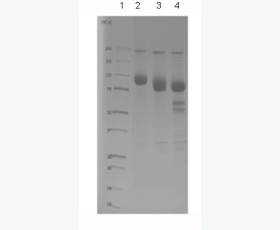Recombinant Human Caspase-14/CASP14
| Product name: | Recombinant Human Caspase-14/CASP14 |
| Source: | E. coli |
| Purity: | Greater than 95% as determined by reducing SDS-PAGE. |
| Buffer Formulation: | Lyophilized from a 0.2 μm filtered solution of 20mM PB,150mM NaCl,pH7.4. |
| Applications: | Applications:SDS-PAGE; WB; ELISA; IP. |
| Storage: | Avoid repeated freeze/thaw cycles. Store at 2-8 oC for one month. Aliquot and store at -80 oC for 12 months. |
| UOM: | 100ug/50ug/200ug/1mg/1g |
| Source | E. coli |
| Description | Recombinant Human Caspase-14 is produced by our E.coli expression system and the target gene encoding Ser2-Gln242 is expressed with a 6His tag at the C-terminus. |
| Names | Caspase-14, CASP-14, CASP14 |
| Accession # | P31944 |
| Formulation | Lyophilized from a 0.2 μm filtered solution of 20mM PB,150mM NaCl,pH7.4. |
| Shipping |
The product is shipped at ambient temperature. |
| Reconstitution |
Always centrifuge tubes before opening. Do not mix by vortex or pipetting. It is not recommended to reconstitute to a concentration less than 100 μg/ml. Dissolve the lyophilized protein in ddH2O. Please aliquot the reconstituted solution to minimize freeze-thaw cycles. |
| Storage |
Lyophilized protein should be stored at < -20°C, though stable at room temperature for 3 weeks. Reconstituted protein solution can be stored at 4-7°C for 2-7 days. Aliquots of reconstituted samples are stable at < -20°C for 3 months. |
| Purity |
Greater than 95% as determined by reducing SDS-PAGE. |
| Endotoxin | Less than 0.1 ng/µg (1 IEU/µg) as determined by LAL test. |
| Amino Acid Sequence |
MSNPRSLEEEKYDMSGARLALILCVTKAREGSEEDLDALEHMFRQLRFESTMKRDPTAEQFQEEL EKFQQAIDSREDPVSCAFVVLMAHGREGFLKGEDGEMVKLENLFEALNNKNCQALRAKPKVYIIQ ACRGEQRDPGETVGGDEIVMVIKDSPQTIPTYTDALHVYSTVEGYIAYRHDQKGSCFIQTLVDVF TKRKGHILELLTEVTRRMAEAELVQEGKARKTNPEIQSTLRKRLYLQLEHHHHHH
|
| Background | Caspase 14 (CASP14) is an enzyme that belongs to the peptidase C14A family. The Caspase 14 protein is complexed of unprocessed caspase-14 and processed 19 kDa (p19) and 10 kDa (p10) subunits. Sequential activation of caspases plays a central role in the execution-phase of cell apoptosis. Caspases exist as inactive proenzymes, which undergo proteolytic processing at conserved aspartic residues to produce two subunits, large and small, that dimerize to form the active enzyme. CASP14 has been shown to be processed and activated by Caspase 8 and Caspase 10 in vitro, and by anti-Fas agonist antibody or TNF-related apoptosis inducing ligand in vivo. The expression and processing of this caspase may be involved in keratinocyte terminal differentiation, which is important for the formation of the skin barrier. It is believed to be a non-apoptotic caspase which is involved in epidermal differentiation, keratinocyte differentiation and cornification. CASP14 probably regulates maturation of the epidermis by proteolytically processing filaggrin. |














